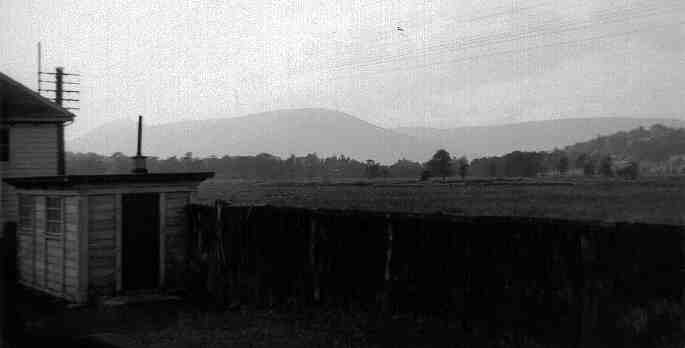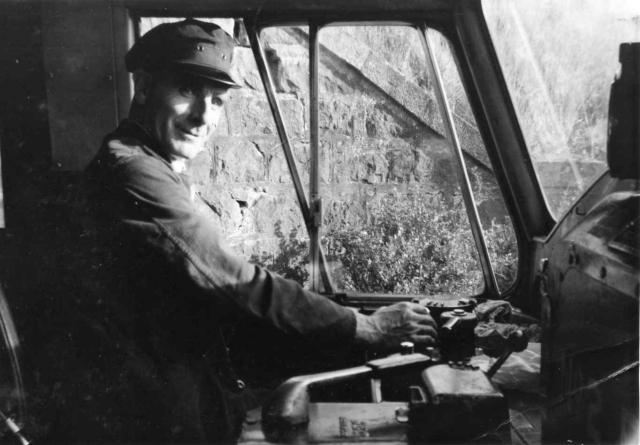Banchory Branch ...... First drive ...... Typhoid Scare
The Royal Deeside line was under Kittybrewster control, but most of the trains were already DMU's and I only ever got overthe branch on two occasions as second man on diesel trips.
On one trip right through to Ballater and the other as far as Culter on a freight trip. This was with a NBL Class 61 locomotive. In spite of their unreliability and being under powered, these
were a very nice locomotive to work on and I liked them very much. However I was completely bowled over when my driver asked if I would like to have a drive. I was very reluctant
but also very keen to experience this so we exchanged chairs. It is a very unnerving experience to sit at the controls of a powerful locomotive for the first time and not really know
what you were doing. Having said that, we had gone though the basic training and knew about signaling and train protection therefore it was simply a matter of concentrating on the
signals and speeds, but of course the driver's eyes were at work too, so it all went nice and easy.
The first time you have to brake for real also makes the andreneline run too . In those days you had to consider the safety of the guard in the brakevan and couldn't brake to heavily. This
is a quick way to learn how to handle a train and apply the brakes with very even pressure. freight trains were also 'loose-coupled' in those days, which meant part of the train didn't have
brakes and you have to rely on the guard applying the handbrake in the van at the right time and then applying the loco straight air brake gently to buffer the train together. Once you have
that in check you can then start to apply the train brake, with equal gentleness and not let the brakes fully release until you come to a stand. Getting the pressures right so that the train
doesn't stop short or overrun the stopping point in part of the art of operating all types, sizes and weights of train.
This cycle of braking operation lasted until fully braked trains came in and the guard's vans were dispensed with. Then you need only concentrate on the train brake as the straight air
brake is only required on a few occasions and while working light locomotive. The straight air, or locomotive brake applies the loco bogie brakes only, while the train, or 'proportional'
brake applies the brakes on the train, while applying a 'proportional' amount of air to the bogie brakes to avoid over braking the loco, which would bump into the train, or when released
allow the weight to tug and possibly snap the coupling.
And that was my first experience of being at the controls of a train.
At this time my home town of Aberdeen was suffering a serious outbreak of Typhoid, where a number of people had died and new cases being reported by the day. Everywhere you
went you had to remember to wash your hands. Every house smelt of disinfectant, but it was a serious outbreak. The city was virtually sealed off and railway men were among the few
who continued to move from place to place. When we arrived in Culter I decided to find a shop and buy something to eat. I found a bakery shop and after waiting my turn in the Que
I ordered. The lady assistant placed my order in a paper bag and said how much and I went to pay, when she suddenly realised I was in railway uniform and she asked if I was from
Aberdeen and when I said yes, she totally refused to serve me and asked me to leave the premises ... she didn't want to handle my money!!! That was the first time I had ever
experienced such prejudice and fear by someone else. I have never forgotten that. When I told my driver about it he was all for going to complain, he seemed to be more annoyed than
I was, But we decided to leave well alone.
The outbreak lasted some weeks and most entertainment places were closed and you were reminded to wash your hands wherever you went. Thankfully, once the all clear was
given things started to settle down within the city, but the news had spread around the world, with the usual over-reaction and tourism was under threat and this was only
quelled when the queen visited Aberdeen as part of the celebrations and tourists followed suite. Every year since 1964 the city holds an annual street parade to celebrate the
end of that time in the City's history.
Oyne Station. Between Inverurie and Inch. Still open in 1964. Taken from the cab of an Aberdeen to Elgin
via Craigellachie NBL loco hauled service. Ben a'chie is in the background.
Kitty Driver Bill Stevens at controls of NBL 6154 at Kennethmont. Sept 23rd 1964. Dufftown Station from
an Aberdeen to Elgin service 1964. Note the whiskey distillery and the Grampian mountain backdrop.
While the station sign no longer exists you can once again see this view on theDufftown-Keith
preserved railway. The wording below the station name explains that you are 463 feet above
sea level.

